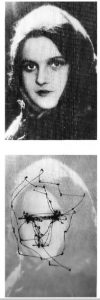Light and Eyeballs
88 Saccades
Learning Objectives
Know what saccades are.
Know why we need saccades.
Being able to view objects such as pictures is a knowledgeable part of the task of seeing. Viewing things is achieved by the orientation of the eyes. This means that you are directing the visual axes to point to a new location. Large movements used when viewing large objects involve coordinated motion from the eyes, head, and body. Small movements used to view smaller objects such as pictures are viewed with just the eyes. The smaller movements are known as saccades. Saccades refers to rapid jerk-like movements of the eyes between fixation points (Fig.8.8.1). Most saccadic movement is involuntary and does not provide us with useful information until fixated on a particular point. Think of saccades as a spotlight on the shore of a beach. They scan over the horizon and lock on to the islands or points of interest in the water. The light darts from one point to the next which allows it to scan its environment in a more efficient manner

Saccades can be produced either voluntarily or involuntarily. The production of saccades is important because they allow for us to direct the fovea onto an object or region of interest. This then enables our mind to begin a high-acuity detail analysis of said object or region.
Scholarpedia, “Human saccadic eye movements” by John Findlay, University of Durham, UK & Robin Walker, Department of Psychology, Royal Holloway, University of London. UK
URL: http://www.scholarpedia.org/article/Human_saccadic_eye_movements
License: CC BY-NC-SA 3.0
Adapted by: Sarah Warden & Jack Anderson

